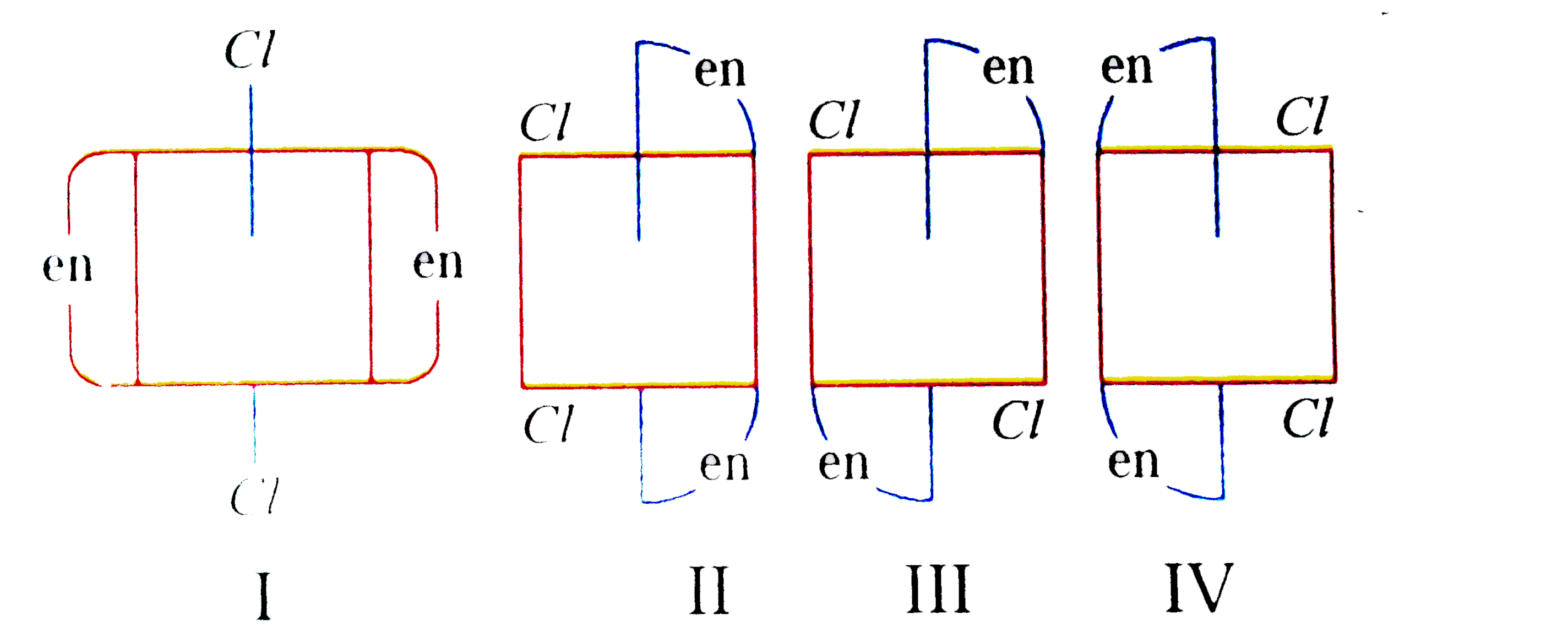Complete Solutions to EXERCISE -3 of chapter COORDINATION COMPLEXES of Class 12 book with complete answers and questions
| Class 12 | CHEMISTRY |
| Chapter | COORDINATION COMPLEXES |
| NARAYANA | EXERCISE -3 |
| Number Of Questions | 15 |
| Academic Year | 2023-24 |
Which of the following statements is not true about the complex ion `[CrCl_(2)(en)_(2)]^(+)`
View SolutionOf the following configurations, the optical isomers are

View SolutionIdentify the geometrical isomers of the following:

View SolutionWhich of the following ions are optically active?

View SolutionHow many isomers are possible for the complex ion `[Cr(NH_(3))(OH)_(2)CI_(3)]^(2-)` ?
View SolutionThe complex ion . `[M(en)Br_(2)I_(2)]^(-1)`, has two optical isomers. Their correct configurations are:
View SolutionMatch the complexes in column I with their properties listed in column II. Indicate your answer by darkening the appropriate bubbles of the `4xx4` matrix given in the ORS.

View SolutionConsider the following complexes:
(I) `K_(2)Ptcl_(6)` (II) `PtCl_(4).2NH_(3)`
(III) `PtCl_(4).3NH_(3)` (IV) `PtCl_(4).5NH_(3)`
Their electrical conductances in an aqueous solution are:
View SolutionThe total possible co-ordination isomers for the following compounds respectively are
(i) `[Co(en)_(3)][Cr(C_(2)O_(4))_(3)]`
(ii) `[Cu(NH_(3))_(4)][CuCl_(4)]`
(iii) `[Ni(en)_(3)][Co(NO_(2))_(6)]`
View SolutionGeometrical isomerism in coordination compounds is exhibited by
View SolutionWhich of the following is not optically active?
View SolutionCoordination compounds plays many important roles in animals and plants. The are essential in the storage and transport of oxygen as electrons transfer agents as catalysts and in photosynthesis Wide range of application in daily life takes place through formation of complexes Photographic fixing qualitative and quantitative analysis purification of water metallurgical extraction are some specific worth mentioning
Arrange of the following in order of decreasing number of unpaired electrons
(I) `[Fe(H_(2)O))_(6)]^(2+)`
(II) `[Fe(CN)_(6)]^(3-)`
(III) `[Fe(CN)_(6)]^(4-)`
(IV) `[fe(H_(2)O)_(6)]^(3+)`
(a) IV,I,II,III
(b) `I,II,III,IV`
(c) `III,II,IIV`
(d) II,III,I,IV` .
View SolutionWhich of the following statements is/are false
View SolutionThe number of unpaired electrons expected for the complex ion `[Cr(NH_(3))_(6)]^(2+)` is :
View SolutionSelect the correct code regarding total number of space isomers for the following compounds:
(I) `[Ma_(3)b_(2)c]^(n+-)`
(II) `[M(AB)_(3)]^(n+-)`
(III) `[Ma_(2)b_(2)c_(2)]^(n+-)`
View Solution
EXERCISE -3 questions and complete solutions for chapter COORDINATION COMPLEXES of NARAYANA CHEMISTRY (HINGLISH) of Class 12
All Exercises from NARAYANA Class 12 CHEMISTRY COORDINATION COMPLEXES
- Additional questions page-155
- C.U.Q
- Comprehension Questions
- Comprehension-1
- Comprehension-2
- Comprehension-3
- Comprehension-4
- Comprehension-5
- Compreshession type question
- EXERCISE -1
- EXERCISE -2
- EXERCISE -3
- EXERCISE -4
- EXERCISE-5
- EXERCISE-6
- EXERCISE-7
- EXERCISE-8
- EXERCISE-9
- FILL IN THE BLANKS
- Integer Type Questions
- LEVEL - IV
- LEVEL - V
- LEVEL-I
- LEVEL-I (H.W)
- LEVEL-II
- LEVEL-II (H.W)
- LEVEL-III
- Matrix Matching Questions
- Multiple Answer Questions
- PREVIOUS AIEEE QUESTIONS
- SINGLE ANSWER QUESTIONS
- Statement Type
- W.E.